Looking for a blackened trout recipe that’ll impress your dinner guests? This smoky, spicy dish combines bold Cajun flavors with delicate fish for a meal that’s both elegant and easy to prepare.
Blackened trout originated in Louisiana Cajun cuisine, where Chef Paul Prudhomme popularized the technique of coating fish with spices and cooking it in a screaming hot cast iron skillet. The result? A beautiful char on the outside while keeping the fish tender and moist inside. You’ll love how the spicy crust contrasts with the mild, flaky flesh of the trout.
This recipe works perfectly with freshwater or rainbow trout and comes together in under 30 minutes. Whether you’re cooking for a special occasion or a weeknight dinner, blackened trout delivers restaurant-quality flavor with minimal effort.
What Is Blackened Trout?
Blackened trout is a signature Louisiana Cajun dish featuring fish coated with spices and quickly seared in a blazing hot cast iron skillet. The cooking technique creates a distinctively dark crust on the outside while maintaining a tender moist interior. This contrast between the bold spicy exterior and the delicate fish makes blackened trout a standout culinary experience.
The blackening technique emerged from Cajun cuisine in the 1980s when Chef Paul Prudhomme introduced it at his New Orleans restaurant. His method involves dipping fish in melted butter then coating it with a spice mixture typically containing paprika cayenne pepper garlic powder onion powder thyme oregano salt and pepper. The fish is then cooked in an extremely hot cast iron skillet causing the spices to char quickly without burning the fish inside.
What sets blackened trout apart from other fish preparations is the intense flavor development from the spice crust. The process isn’t about burning the food but rather creating a deeply seasoned outer layer through the Maillard reaction where proteins and sugars transform at high heat. Trout works exceptionally well for blackening because its mild flavor provides the perfect canvas for the robust spice blend.
Rainbow trout is most commonly used for this preparation but any variety of trout works beautifully. The fish’s natural oils help keep it moist during the high-heat cooking process. Traditional blackening creates some smoke so proper kitchen ventilation is recommended when preparing this dish at home.
Why You’ll Love This Blackened Trout Recipe
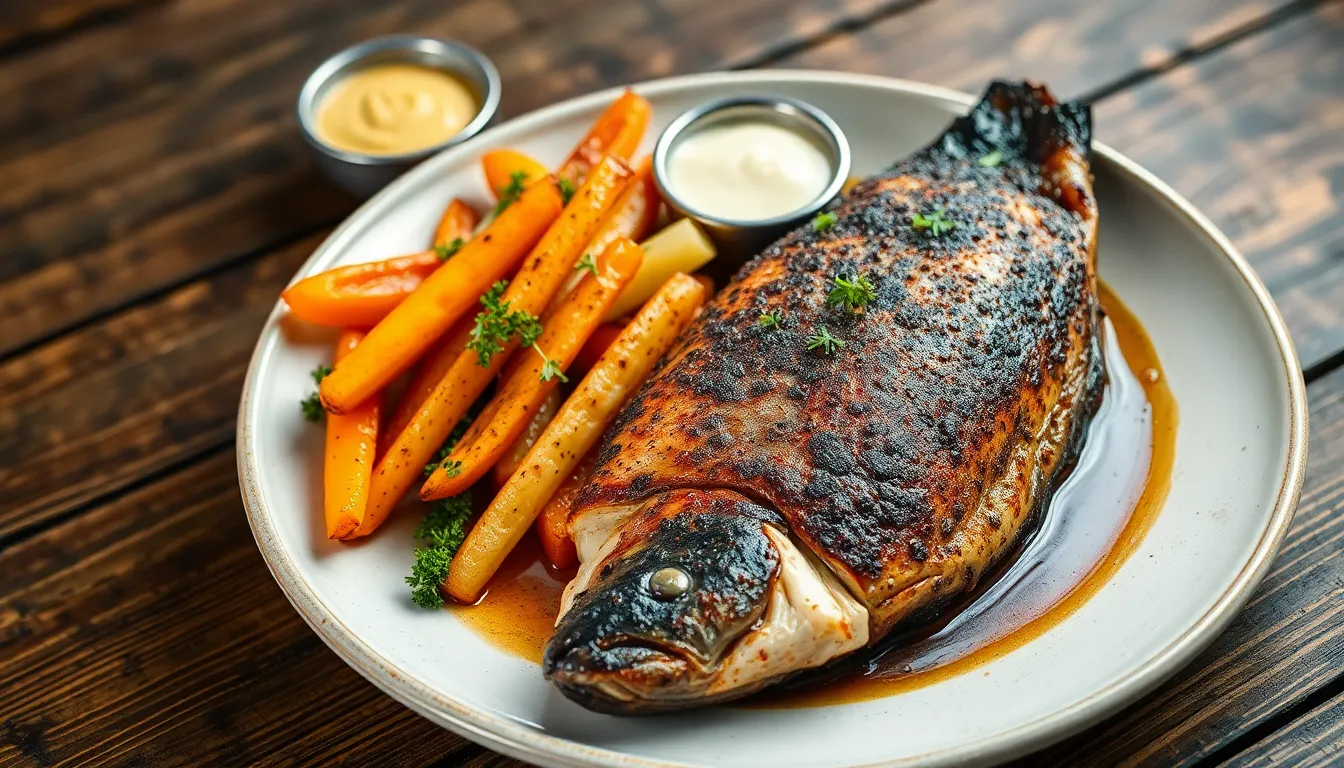
Health-Packed Protein Source – Trout delivers exceptional nutritional value as a lean protein packed with omega-3 fatty acids that support heart health and reduce inflammation. This fish typically contains lower mercury levels than many other seafood options since it’s often sourced from lakes rather than oceans.
Perfect Balance of Flavors – The mild character of trout creates an ideal canvas for the bold blackening spices. Your taste buds will experience a harmonious combination of smoky paprika, spicy cayenne, and aromatic herbs that enhance the fish without overwhelming its natural delicate flavor.
Quick Weeknight Solution – From prep to plate in just 15 minutes, this blackened trout recipe fits perfectly into busy schedules. The rapid cooking time preserves the fish’s moisture while developing that signature charred crust that makes blackened dishes so appealing.
Customizable Heat Level – Adjust the cayenne pepper amount to suit your preference for spiciness. The recipe works beautifully whether you prefer a gentle warmth or a fiery kick that showcases authentic Cajun inspiration.
Impressive Yet Simple – This restaurant-quality dish requires minimal cooking skills but delivers maximum flavor impact. The dramatic presentation of the darkened spice crust against the light flesh of the trout makes for an eye-catching meal that appears far more complex than it actually is to prepare.
Versatile Pairing Options – Serve your blackened trout alongside steamed rice for a classic combination, grilled vegetables for a light meal, or with tangy horseradish-infused tartar sauce for a delightful contrast to the spicy fish.
Key Ingredients for Blackened Trout
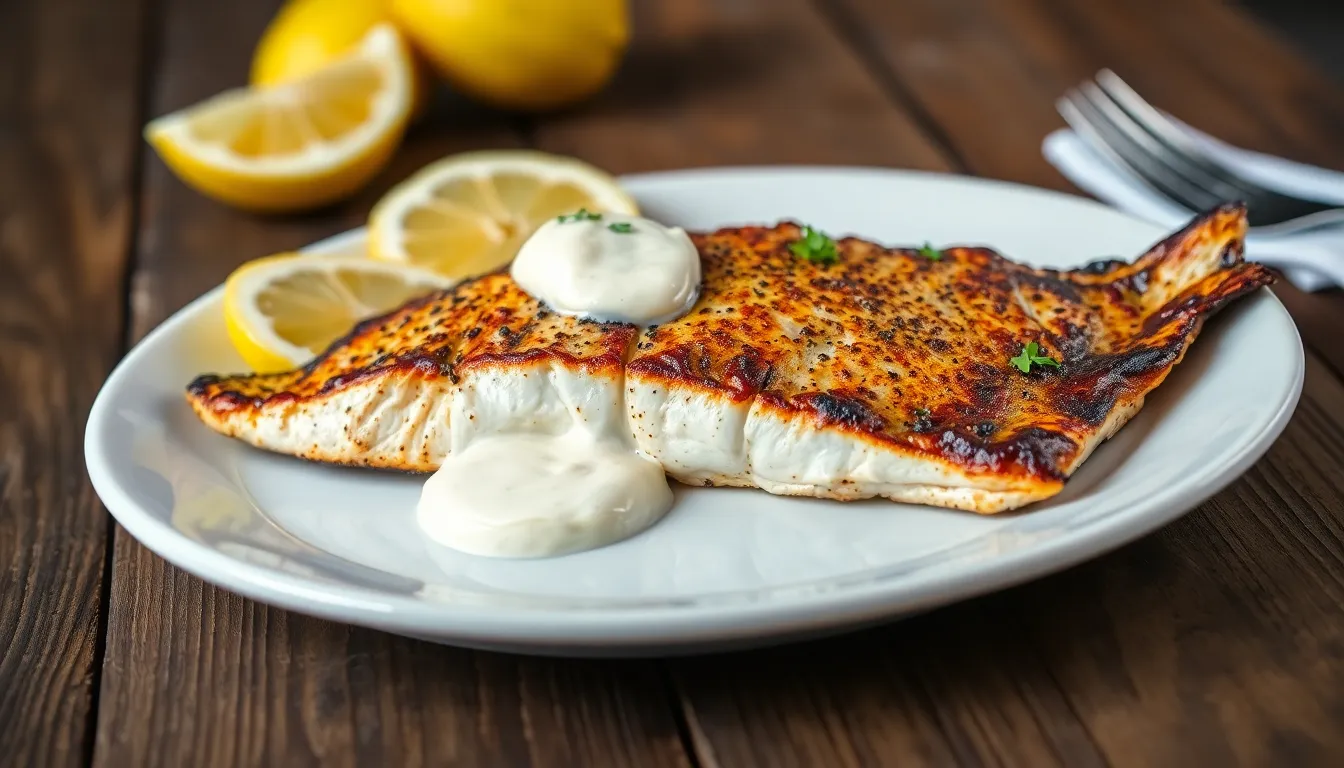
Creating perfect blackened trout relies on selecting quality ingredients and preparing the right spice blend. Each component contributes to the signature Cajun flavors and crispy texture that make this dish so beloved.
The Perfect Fish Selection
Trout stands out as an ideal choice for blackening due to its mild flavor profile and firm texture that holds up well to high-heat cooking. Fresh trout fillets in the 4-6 oz range provide the optimal portion size for even cooking and a beautiful presentation on the plate. Lake trout, rainbow trout, and steelhead trout all work wonderfully with this preparation method, giving you flexibility based on what’s available at your local market.
This fish offers impressive nutritional benefits alongside its culinary appeal. Trout contains high levels of omega-3 fatty acids that support heart health while providing lean protein with fewer contaminants than many other fish varieties. The natural oils in trout help maintain moisture during the intense blackening process, resulting in a perfectly cooked fish that remains tender inside even though the crusty exterior.
Blackening Spice Blend
The distinctive seasoning mixture is the heart of any blackened trout recipe, delivering the signature bold Cajun flavors. A traditional blackening blend combines several key spices in exact proportions to achieve the perfect balance of heat, earthiness, and aromatics.
For an authentic homemade blackening mixture, combine:
- 1 tablespoon paprika
- 1 tablespoon smoked paprika
- 1 teaspoon garlic powder
- 1 teaspoon onion powder
- 1 teaspoon dried thyme
- 1 teaspoon dried oregano
- 1 teaspoon salt
- 1/2 teaspoon cayenne pepper (adjust according to heat preference)
- 1/2 teaspoon black pepper
This powerful spice blend creates the characteristic dark crust through the Maillard reaction when seared at high temperatures. Regular paprika provides color while smoked paprika adds depth and complexity to the flavor profile. Cayenne pepper determines the heat level, allowing you to customize the spiciness based on your preference.
Additional Ingredients
Beyond the fish and spice blend, a few supporting ingredients elevate blackened trout to its full potential. Butter or high-heat cooking oil serves as the foundation for proper blackening, helping the spices adhere to the fish while creating the signature crust when seared in a blazing hot cast iron skillet.
Fresh citrus brings brightness to the finished dish, with a squeeze of lime or lemon juice cutting through the richness and spice. This acidic element balances the robust flavors and completes the flavor profile. Many chefs serve blackened trout with a cooling remoulade sauce on the side, typically made from mayonnaise, mustard, paprika, chopped pickles, and fresh parsley.
Quality butter makes a difference in this recipe, both for coating the fish before applying the spice blend and for finishing the dish with a luxurious richness. The butter helps the spices stick to the fish surface while improving flavor development during the intense cooking process.
Equipment Needed
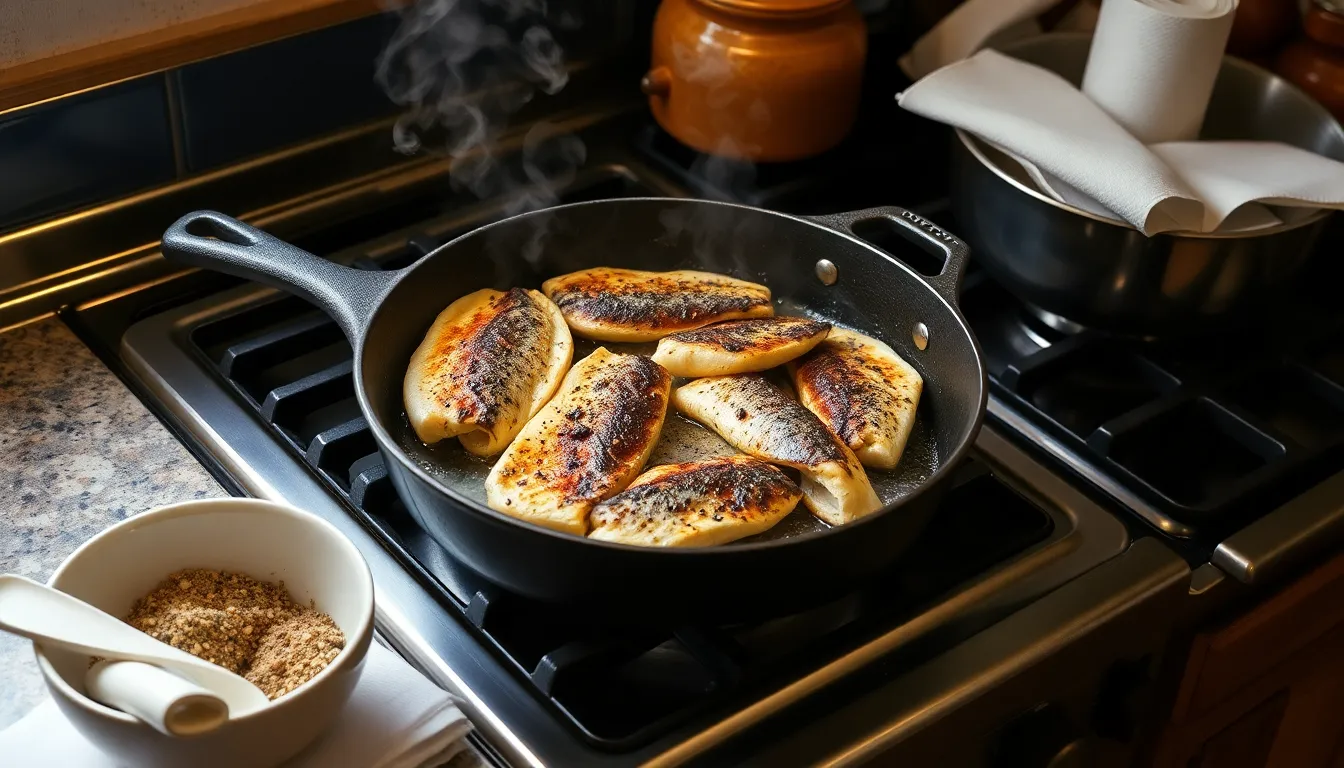
Preparing blackened trout requires exact tools to achieve that perfect charred crust while maintaining a moist interior. Gather these essential items before you begin cooking:
- Cast Iron Skillet: The foundation of proper blackening technique, a well-seasoned cast iron skillet provides the intense, even heat distribution necessary for creating that signature crust. The heavy-bottomed surface maintains consistent temperature throughout the cooking process.
- Fish Spatula: A thin, flexible spatula helps you flip the delicate trout fillets without breaking them apart. The slotted design also allows excess butter to drain away during turning.
- Mixing Bowl: You’ll need a medium bowl for combining your blackening spices. Choose one large enough to accommodate your spice blend with room for thorough mixing.
- Measuring Spoons: Precise measurements ensure your blackening seasoning has the right balance of flavors from chili powder, paprika, and other spices.
- Paper Towels: Keep these handy for patting the trout fillets dry before applying seasoning, which helps the spices adhere better to the fish.
- Heat-Resistant Gloves: Optional but recommended for safety when working with the extremely hot cast iron skillet.
- Instant-Read Thermometer: While experienced cooks can judge doneness by sight, a thermometer takes the guesswork out of cooking fish to the perfect temperature (145°F).
- Plate or Shallow Dish: This provides an ideal surface for seasoning the trout fillets before they hit the skillet.
- Ventilation: Not equipment per se, but ensure your kitchen has good airflow or an effective range hood, as the blackening process can generate important smoke.
How To Make Blackened Trout
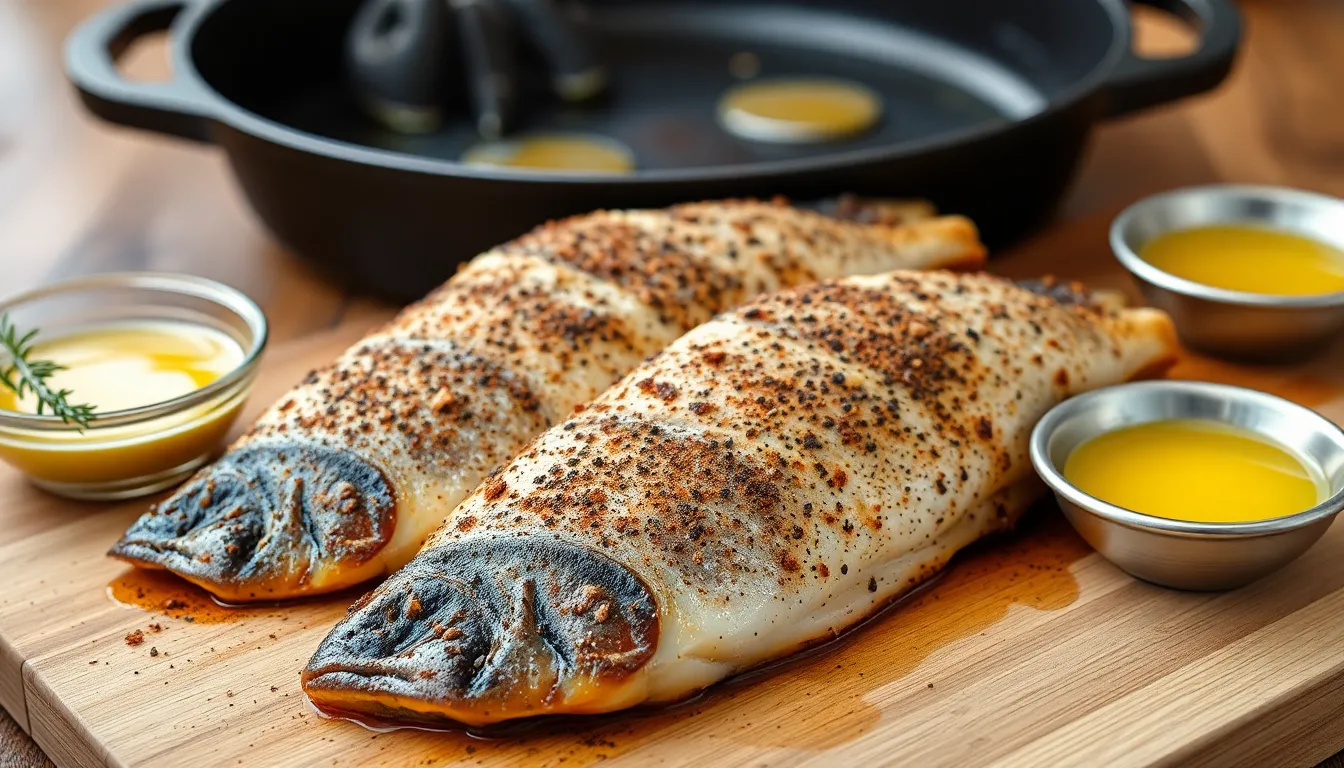
Creating perfectly blackened trout requires attention to detail and proper technique. Follow these simple steps to achieve that signature charred crust while maintaining a tender, moist interior.
Preparing The Trout
Start with fresh trout fillets, either lake or sea trout varieties work excellently for this preparation. Pat the fillets completely dry with paper towels to remove all excess moisture. This crucial step ensures the seasoning adheres properly to the fish surface and promotes even cooking. Removing moisture also helps achieve that perfect blackened crust characteristic of the dish. Keep the fillets at room temperature for about 10 minutes before seasoning to ensure even cooking.
Making The Blackening Seasoning
Combine these ingredients in a mixing bowl to create your flavorful blackening spice mix:
- 1 tablespoon paprika
- 2 teaspoons salt
- 1/2 teaspoon cayenne pepper (adjust to your heat preference)
- 3/4 teaspoon white pepper
- 3/4 teaspoon black pepper
- 1/2 teaspoon dried thyme
- 1/2 teaspoon dried oregano
- 1 teaspoon onion powder
- 1 teaspoon garlic powder
Mix thoroughly until all spices are evenly distributed. For variations, consider incorporating smoked paprika for added depth, Old Bay seasoning for a seafood-forward flavor, or Everglades Fish and Chicken seasoning for a regional twist. This seasoning blend can be made ahead and stored in an airtight container for future use.
Coating The Fish
Melt 1/4 to 1/2 cup of unsalted butter in a small bowl. Dip each trout fillet into the melted butter, ensuring both sides are completely coated. Alternatively, brush the butter onto the fillets for more controlled application. Generously sprinkle the blackening seasoning onto both sides of the buttered fillets. Press the seasoning firmly onto the surface of the fish to ensure it adheres well. The butter acts as both a flavor enhancer and a binding agent for the spices, creating that distinctive blackened crust during cooking.
Cooking The Blackened Trout
Preheat a cast iron skillet over medium-high heat until it becomes very hot. Add a small amount of butter to the skillet and allow it to melt completely. Place the seasoned trout fillets in the hot skillet, being careful not to overcrowd the pan. Cook for approximately 2-3 minutes on the first side until a dark, almost charred crust develops. Flip the fillets carefully using a fish spatula and cook the second side for another 2-3 minutes until crispy. The entire cooking process should take between 4-6 minutes total, depending on the thickness of your fillets. The high heat creates the signature blackened exterior while sealing in moisture and flavor.
Testing For Doneness
Check for doneness by gently inserting a fork into the thickest part of the fillet – the fish should flake easily but still remain moist inside. Look for firm flesh that has turned opaque throughout. The internal temperature should reach approximately 145°F (63°C) when measured with an instant-read thermometer. Avoid overcooking as this will dry out the fish and diminish its delicate flavor. The blackened crust should appear dark but not burnt, with a pleasant smoky aroma. Remove the fish from the skillet immediately once done to prevent overcooking from residual heat.
Serving Suggestions
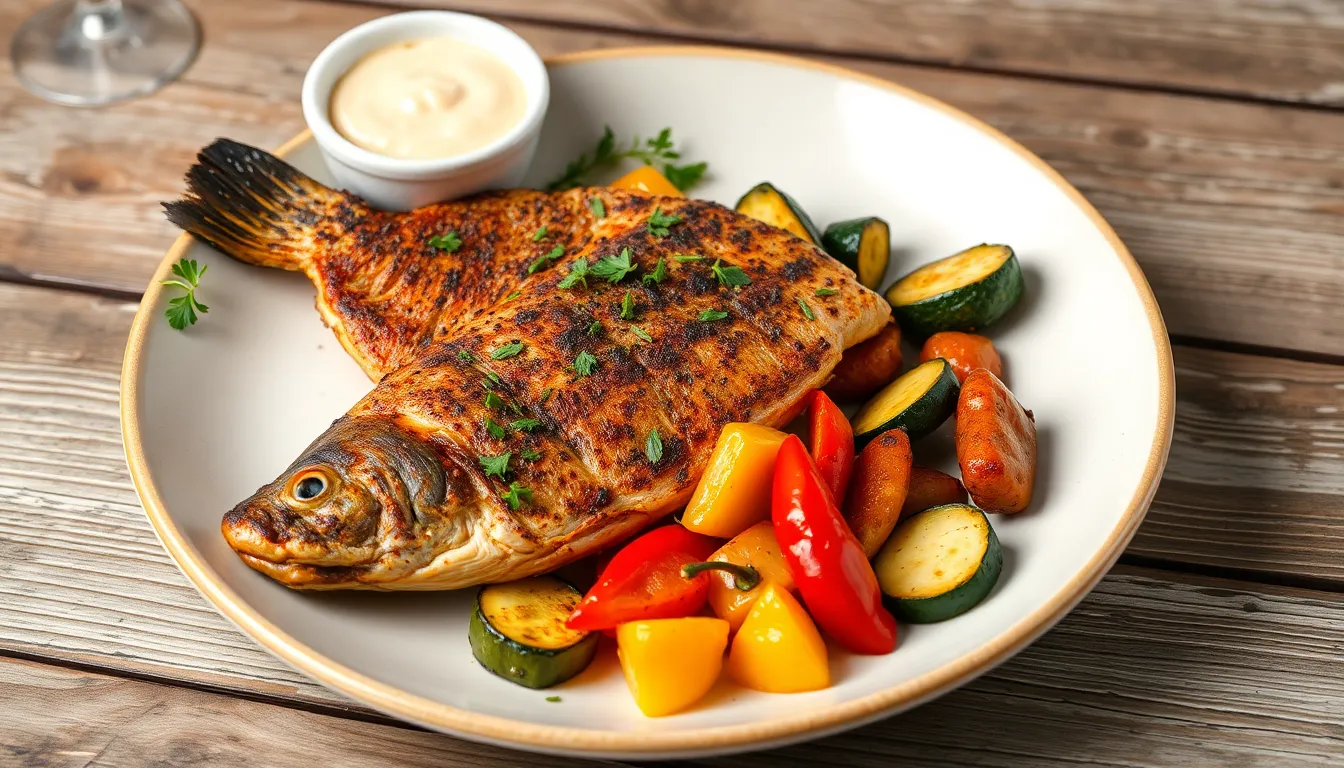
Blackened trout delivers bold Cajun flavors that pair beautifully with the right accompaniments. The following suggestions will help you create a complete and balanced meal that complements the spicy charred crust and delicate fish texture.
Side Dish Pairings
Traditional Southern and Cajun-inspired sides enhance the authentic experience of blackened trout. Roasted or sautéed vegetables like okra, zucchini, squash, and bell peppers provide colorful contrast while maintaining the regional theme. Try serving your trout with a Mediterranean quinoa pilaf featuring cherry tomatoes and roasted peppers for a nutritious grain option. Brown rice makes an excellent neutral base that soaks up the flavorful spices from the fish. Simple roasted potatoes offer heartier fare that balances the bold seasoning profile of the blackened trout. Fresh green salads with light vinaigrette dressing cut through the richness and spice, creating a refreshing counterpoint. Steamed greens such as collards or kale provide traditional Southern flair while adding nutritional value to your meal.
Sauce Options
Your blackened trout can stand alone with its robust flavor profile, but the right sauce elevates the dish to new heights. Classic lemon butter sauce drizzled over the fish brightens the smoky, spicy notes while adding richness. Melted herb butter infused with parsley, dill, and chives makes a simple yet elegant topping that complements without overwhelming. Cool, creamy remoulade sauce offers traditional Cajun contrast to the heat of the blackening spices. Tartar sauce provides a tangy counterpoint that helps balance the intensity of the seasoning blend. Authentic Cajun or Creole sauces featuring tomatoes and peppers reinforce the regional flavor profile while adding complexity. For a lighter option, a simple squeeze of fresh lemon and a sprinkle of chopped herbs keeps the focus on the trout’s delicate texture and seasoning. Consider serving sauces on the side to allow guests to adjust flavors according to their preference.
Storage and Reheating Tips
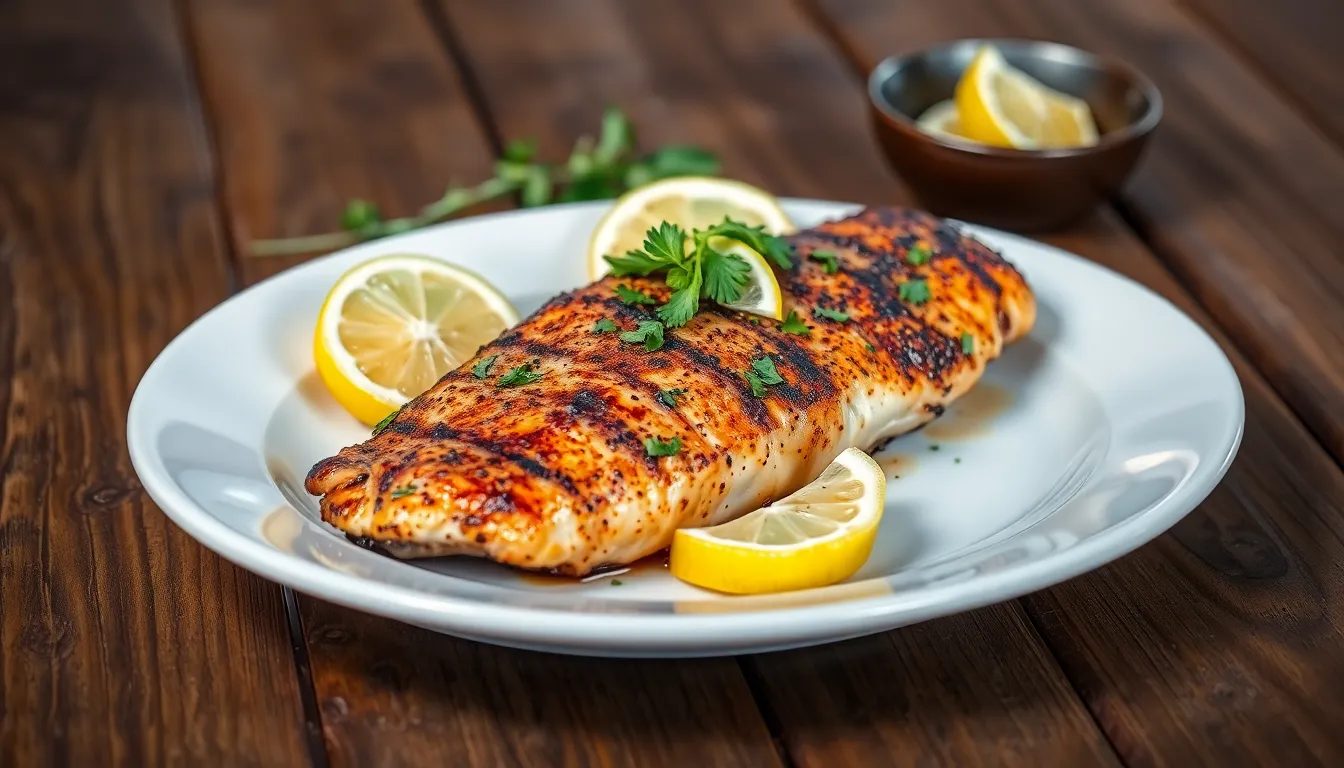
Properly storing and reheating your blackened trout ensures you can enjoy this flavorful Cajun dish even after the initial meal. Follow these guidelines to maintain the quality and taste of your leftover blackened trout.
Storing Leftover Blackened Trout
Store your leftover blackened trout in an airtight container to preserve its freshness and prevent any contamination. Refrigerate promptly after your meal rather than letting it sit at room temperature for extended periods. Consume the stored trout within 3 to 4 days for optimal quality and food safety.
Due to its spicy seasoning and unique cooking method blackened trout doesn’t maintain its ideal texture and flavor for long periods. Plan to enjoy your leftovers sooner rather than later for the best experience.
Best Practices for Reheating
Reheating blackened trout requires care to preserve its moisture and delicate texture. The fish can easily dry out or become overcooked if reheated improperly.
Oven Method (Recommended):
- Preheat your oven to 325°F (160°C)
- Place the trout on a baking sheet
- Brush the fish with a light coating of butter or olive oil to maintain moisture
- Cover loosely with aluminum foil
- Heat for 10-15 minutes depending on the thickness until warmed through
Stovetop Method:
- Heat a skillet over low to medium heat
- Add a small amount of butter or oil
- Place the trout in the pan
- Cover with a lid
- Warm for 2-3 minutes per side until heated through
Avoid microwaving your blackened trout as this cooking method applies too much heat too quickly which dries out the fish and intensifies the fishy aroma through oxidation. The microwave also tends to make the crust soggy rather than maintaining its signature texture.
Tips for Maintaining Flavor and Texture
Preserve the quality of your reheated blackened trout by adding moisture before reheating. Drizzle the fish with melted butter lemon juice or a light sauce to keep it from drying out during the reheating process.
Always cover the trout when reheating to trap steam and distribute heat evenly throughout the fish. This technique helps maintain the moist interior that makes blackened trout so enjoyable.
Keep the reheating temperature low and the time short to prevent overcooking. Blackened trout is delicate and continues cooking even after being removed from heat so check it frequently during reheating.
Variations To Try
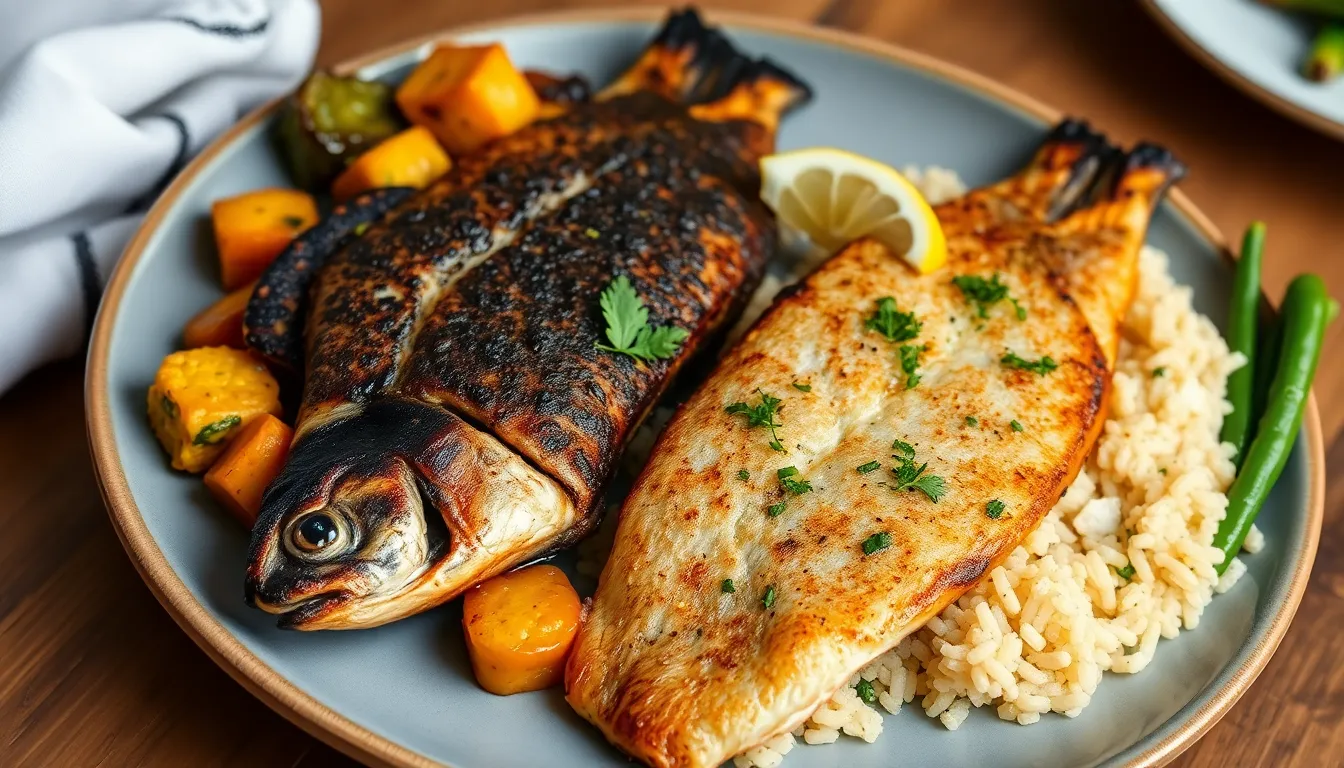
While the classic blackened trout recipe delivers exceptional flavor, experimenting with different seasoning profiles can create exciting new taste experiences. Here are two popular variations that showcase the versatility of this cooking technique.
Cajun-Style Blackened Trout
Authentic Cajun-style blackened trout kicks up the heat and richness for a true Louisiana experience. This variation features a more robust spice blend that includes additional chili powder, extra cayenne pepper, and aromatic herbs like thyme and oregano. You’ll want to incorporate butter into the cooking process rather than just oil, as it adds a distinctive richness that’s characteristic of traditional Cajun cuisine. The liberal use of cayenne pepper creates that signature Cajun heat that warms your palate without overwhelming the delicate fish flavor. Serve your Cajun blackened trout with classic Southern sides such as stewed okra, dirty rice, or cornbread to complete this regional specialty. The combination of high heat cooking and bold spices creates a dark flavorful crust that seals in moisture while delivering authentic Cajun flavor.
Lemon Herb Blackened Trout
For a lighter and brighter twist on blackened trout, the lemon herb variation offers a refreshing alternative. This approach incorporates fresh or dried herbs such as thyme, oregano, and garlic with vibrant lemon zest or juice mixed into the blackening seasoning. You’ll tone down the traditional spicy elements while amplifying the herbaceous notes, creating a more subtle but equally flavorful crust. The citrus component adds brightness that enhances the natural sweetness of the trout. This variation pairs beautifully with herbed coconut milk rice or light vegetable sides like asparagus or green beans. Fresh dill makes an excellent addition to this version, complementing both the lemon and the trout’s delicate flavor profile. For maximum impact, finish your lemon herb blackened trout with a squeeze of fresh lemon just before serving to brighten all the flavors.
Nutritional Benefits of Trout

Trout offers an impressive nutritional profile that makes it an excellent choice for health-conscious diners. This delicious fish delivers substantial protein with relatively few calories making it ideal for balanced meal planning.
A typical 5-ounce serving of blackened steelhead trout contains approximately 201 calories while providing about 25 grams of high-quality protein. This represents roughly 36% of your daily protein requirements in just one serving. For larger portions around 1 cup (235 grams) you’ll get about 294 calories and 41 grams of protein.
The omega-3 fatty acid content in trout deserves special attention. These essential fats support heart health reduce inflammation throughout the body and contribute to optimal brain function. Even though containing 8.8 to 12 grams of total fat per serving trout remains relatively low in saturated fat with only 0.9 to 2.3 grams depending on portion size.
Trout also provides valuable micronutrients your body needs. You’ll get approximately:
- 8% of your daily potassium needs
- Calcium for bone health
- Iron for oxygen transport
- Variable amounts of vitamin D depending on preparation
The blackening technique adds minimal carbohydrates to the dish with most preparations containing only 0-6 grams per serving. This makes blackened trout an excellent option for low-carb dietary approaches.
| Nutrient | Amount (per serving) | % Daily Value |
|---|---|---|
| Calories | 200-300 kcal | – |
| Protein | 25-41g | ~36% |
| Total Fat | 0.9-12g | – |
| Saturated Fat | 0-2.3g | – |
| Carbohydrates | 0-6g | – |
| Potassium | – | ~8% |
| Calcium | 18-35mg | 1% |
| Iron | 0.3-1.2mg | 2% |
| Cholesterol | 45-94mg | 15% |
| Sodium | 63-705mg | Varies by preparation |
The spice blend used in blackened trout adds another nutritional dimension to this already healthy dish. Spices like paprika cayenne and garlic powder contribute antioxidant properties that help protect your cells from damage while adding negligible calories.
When compared to fattier fish varieties trout generally contains lower levels of environmental contaminants including mercury making it a safer choice for regular consumption. The combination of complete protein heart-healthy fats and essential minerals positions blackened trout as a truly nutritious centerpiece for any meal.
Final Tips For Perfect Blackened Trout
Blackened trout brings the bold flavors of Louisiana Cajun cuisine right to your dinner table with minimal effort. Remember that the key to perfection lies in a screaming hot cast iron skillet and thoroughly dried fish. Don’t rush the process – let your pan heat properly for that signature char.
You’ll know you’ve mastered this technique when your trout has a deep brown crust outside while remaining tender and flaky inside. Feel free to adjust the spice levels to suit your taste preferences.
With its impressive presentation health benefits and quick preparation blackened trout deserves a spot in your regular meal rotation. Whether you’re cooking for a special occasion or a weeknight dinner this versatile dish proves that extraordinary flavor doesn’t require extraordinary effort.
Frequently Asked Questions
What is blackened trout?
Blackened trout is a signature Louisiana Cajun dish where fish is coated with spices and quickly seared in a blazing hot cast iron skillet. This technique creates a distinctive dark crust on the exterior while keeping the interior tender and moist. The method was popularized in the 1980s by Chef Paul Prudhomme and relies on the Maillard reaction to develop complex flavors.
How long does it take to make blackened trout?
Blackened trout is a surprisingly quick dish to prepare, taking just about 15 minutes from prep to plate. This makes it perfect for busy weeknights while still delivering restaurant-quality flavor. The actual cooking time is very short—just a few minutes per side—but the results are impressive enough for special occasions.
Is blackened trout healthy?
Yes, trout is a nutritious choice. It’s a lean protein rich in omega-3 fatty acids that support heart health and typically has lower mercury levels than other fish. A 5-ounce serving of blackened steelhead trout contains approximately 201 calories and 25 grams of protein (about 36% of daily requirements). It’s also low in saturated fat and provides essential micronutrients including potassium, calcium, and iron.
What equipment do I need to make blackened trout?
Essential equipment includes a well-seasoned cast iron skillet for even heat distribution, a fish spatula for flipping delicate fillets, a mixing bowl for combining spices, measuring spoons for precise seasoning, and paper towels for drying the fish. Optional items include heat-resistant gloves for safety and an instant-read thermometer for checking doneness. Good kitchen ventilation is important due to smoke.
What spices are used in blackened seasoning?
Traditional blackening seasoning includes a blend of paprika (for color and mild heat), cayenne pepper (for spiciness), garlic powder, onion powder, dried thyme, dried oregano, salt, and black pepper. You can adjust the cayenne pepper to customize the heat level according to your preference. This spice mixture not only adds flavor but also contributes antioxidant properties with minimal calories.
Can I use any type of trout for this recipe?
Yes, while rainbow trout is commonly used, any variety of trout works well for blackening. Both freshwater and steelhead trout are excellent choices. Trout is particularly suitable for this cooking method because of its mild flavor profile and natural oils that help retain moisture during the high-heat cooking process.
What sides go well with blackened trout?
Traditional Southern and Cajun-inspired sides complement blackened trout perfectly. Consider serving it with roasted vegetables, quinoa pilaf, brown rice, or fresh salads. For a more authentic experience, pair with cornbread, collard greens, or dirty rice. You can also elevate the dish with sauces like lemon butter, remoulade, or tartar sauce.
How do I store and reheat leftover blackened trout?
Store leftover trout in an airtight container in the refrigerator and consume within 3-4 days. For reheating, avoid the microwave as it can dry out the fish. Instead, use an oven (covered with foil at 275°F for 10-15 minutes) or gently reheat in a skillet over medium-low heat. These methods help preserve the moisture and texture of the fish.
Can I make blackened trout without creating a lot of smoke?
While some smoke is characteristic of the blackening process, you can minimize it by using a lower heat setting and cooking for slightly longer. Ensure your kitchen is well-ventilated by turning on the exhaust fan and opening windows. Alternatively, you can also prepare this dish on an outdoor grill with a cast iron skillet for a smoke-free indoor experience.
Are there variations to traditional blackened trout?
Yes, popular variations include Cajun-Style Blackened Trout with a robust spice blend and traditional Cajun sides, and Lemon Herb Blackened Trout featuring fresh herbs and citrus for a lighter flavor profile. You can also experiment with different spice combinations or add ingredients like brown sugar for sweetness or smoked paprika for depth.
